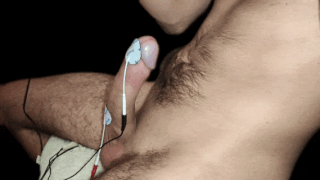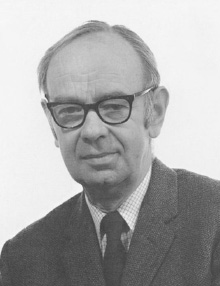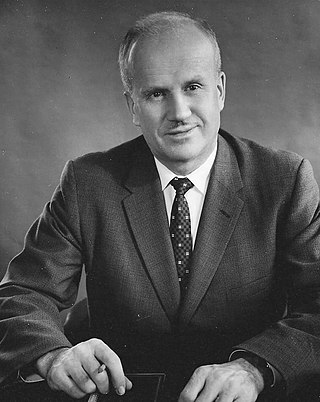Related Research Articles

Artificial insemination is the deliberate introduction of sperm into a female's cervix or uterine cavity for the purpose of achieving a pregnancy through in vivo fertilization by means other than sexual intercourse. It is a fertility treatment for humans, and is a common practice in animal breeding, including dairy cattle and pigs.
Insemination is the introduction of sperm into a female's reproductive system for the purpose of impregnating, also called fertilizing, the female for sexual reproduction. The sperm is introduced into the uterus of a mammal or the oviduct of an oviparous (egg-laying) animal. In mammals, insemination normally occurs during sexual intercourse or copulation, but insemination can take place in other ways, such as by artificial insemination.

Electroejaculation is a procedure used to obtain semen samples from sexually mature male mammals. The procedure is used for breeding programs and research purposes in various species, as well as in the treatment of ejaculatory dysfunction in human males. This procedure is used frequently with large mammals, particularly bulls and some domestic animals, as well as humans who have certain types of anejaculation. Electroejaculation has also been used for the cryoconservation of animal genetic resources, where semen is stored in low temperatures with the intent of conserving genetic material and future revival.

Semen collection refers to the process of obtaining semen from human males or other animals with the use of various methods, for the purposes of artificial insemination, or medical study. Semen can be collected via masturbation, prostate massage, artificial vagina, penile vibratory stimulation (vibroejaculation) and electroejaculation. Semen can be collected from endangered species for cryopreservation of genetic resources.
Jay Laurence Lush was a pioneering animal geneticist who made important contributions to livestock breeding. He is sometimes known as the father of modern scientific animal breeding. Lush received National Medal of Science in 1968 and the Wolf Prize in 1979.
Sir John Hammond CBE FRS PhD, was a physiologist, agricultural research scientist, veterinarian known for his pioneering work in artificial insemination. He gives his name to the Sir John Hammond Memorial Prize.
The BAIF Development Research Foundation is a NGO based in Urali Kanchan near Pune in Maharashtra, India, that pioneers agricultural development. It was founded in 1967 by Manibhai Desai as the Bharatiya Agro Industries Foundation. Under Manibhai, BAIF pioneered cross breeding of high yielding European cattle such as Holstein Freisian and Jersey with the sturdy Indian breeds such as Gir from Gujarat. Later BAIF expanded the scope of activities to include animal health, nutrition, afforestation wasteland development, and tribal development.

Frozen bovine semen is a method of preserving bovine semen for future artificial insemination, even after the death of the donor.

The Australian Charbray is an Australian breed of cattle derived from a cross between the French Charolais cattle and American Brahman cattle. The charbray breed was first conceived in the United States of America in the 1930s and later introduced into Australia in 1969. In Australia, Australian charbray breeders are concentrated in the tropical Northern regions of Queensland. As of 1977, the official breeder society of Charbray cattle in Australia and New Zealand is the Charbray Society of Australia Limited, responsible for recording Charbray cattle in herd books, fostering improvement, enhancement and sales of Charbray cattle.

Alan Robertson was an English population geneticist. Originally a chemist, he was recruited after the Second World War to work on animal genetics on behalf of the British government, and continued in this sphere until his retirement in 1985. He was a major influence in the widespread adoption of artificial insemination of cattle.

Stephen Taber III. was an American apiologist, noted authority and author in the field of artificial insemination of queen bees for the purpose of developing disease resistant and gentle bee colonies.
In Sri Lanka many farmers depend on animal husbandry for their livelihood, but not a large proportion. Therefore, many livestock products have to be imported. The main livestock products in Sri Lanka are milk, meat and eggs. Hides, wools and other products are still not produced within the country. Animal power formerly used in the cultivation of rice and vegetables have been replaced by modern technology to farmlands. However animal husbandry plays an important role in the rural economy for improving the living conditions of farmers in the country.

Ernest John Christopher Polge was an English biologist, most noted for his work in cryopreservation.
Henry A. Lardy NAS AAA&S APS was a biochemist and professor emeritus in the biochemistry department at the University of Wisconsin-Madison. He was elected to the National Academy of Sciences in 1958, the American Academy of Arts and Sciences in 1965, and the American Philosophical Society in 1976. Research in Lardy's laboratory centered on elucidating the mechanisms underlying metabolism.
In agriculture, estrous synchronization is used to facilitate breeding by artificial insemination.
The Animal Reproduction Research Institute (ARRI) may be considered to date back to 1968 when the first center for bull investigation in Egypt was established. Its main responsibilities were the examination of bulls used for artificial insemination or natural breeding purposes, in addition to examining samples received from districts throughout Egypt for diagnostic purposes. long before that time, however, different aspects of animal reproduction were practiced in an informal, and later, formal manner. for example, artificial insemination has been applied in a primitive fashion for hundreds of years. Fresh semen, collected from newly impregnated female animals, was injected into other female animals.

JoGayle Dillon Howard was an American zoologist and theriogenologist specializing in the captive breeding of endangered species such as pandas, clouded leopards, and black-footed ferrets.

The Artificial Insemination Centre of Quebec (CIAQ) is a limited partnership society founded in 1948 located in Saint-Hyacinthe, Quebec, Canada with the mission of improving through artificial insemination bovine herds used in milk and meat production throughout the province. The CIAQ is currently the sole bovine sperm production facility in Quebec and is the propriety of the Milk Producers of Quebec (PLQ), the Quebec Council of Milk Producing Breeds (CQRL) and the Provincial Council of Cattle Amelioration Clubs (CPCAB).

Dr. Ernest Mercier, OC was a reputed agronomist in Quebec, Canada. Born on a family farm in Notre-Dame-du-Rosaire, he went on to do graduate studies in Cornell University and founded the Artificial Insemination Center of Quebec. After many years as the superintendent at a federal research farm, he was promoted deputy minister of agriculture of Quebec, a position which he held for 6 years. Retiring from his government work, he became a private consultant and collaborated with the Canadian International Development Agency and the Canadian delegation at the Food and Agriculture Organization on projects that took him around the world.
Central Cattle Breeding and Dairy Farm is a Bangladesh government owned cattle breeding farm and research cenre. It is located in Savar Upazila besides Jahangirnagar University. Dr. Mohammad Ali is the Managing Director of the farm.
References
- ↑ "Dr John O. Almquist" . Retrieved 2023-10-04.
- ↑ "Penn State mourns John Almquist, pioneering dairy physiologist" . Retrieved 2023-10-04.
- ↑ "John O. Almquist". Wolf Foundation. Retrieved 2023-10-04.
- ↑ "Penn State mourns John Almquist, pioneering dairy physiologist" . Retrieved 2023-10-04.
- ↑ "Dr John O. Almquist" . Retrieved 2023-10-04.